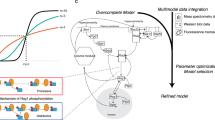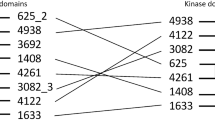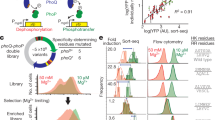Abstract
Eukaryotic protein kinase pathways have both grown in number and changed their network architecture during evolution. We wondered if there are pivotal proteins in these pathways that have been repeatedly responsible for forming new connections through evolution, thus changing the topology of the network; and if so, whether the underlying properties of these proteins could be exploited to re-engineer and rewire these pathways. We addressed these questions in the context of the mitogen-activated protein kinase (MAPK) pathways. MAPK proteins were found to have repeatedly acquired new specificities and interaction partners during evolution, suggesting that these proteins are pivotal in the kinase network. Using the MAPKs Fus3 and Hog1 of the Saccharomyces cerevisiae mating and hyper-osmolar pathways, respectively, we show that these pivotal proteins can be re-designed to achieve a wide variety of changes in the input-output properties of the MAPK network. Through an analysis of our experimental results and of the sequence and structure of these proteins, we show that rewiring of the network is possible due to the underlying modular design of the MAPKs. We discuss the implications of our findings on the radiation of MAPKs through evolution and on how these proteins achieve their specificity.
This is a preview of subscription content, access via your institution
Access options
Subscribe to this journal
Receive 12 print issues and online access
$209.00 per year
only $17.42 per issue
Buy this article
- Purchase on Springer Link
- Instant access to full article PDF
Prices may be subject to local taxes which are calculated during checkout





Similar content being viewed by others
References
Manning, G., Plowman, G. D., Hunter, T. & Sudarsanam, S. Evolution of protein kinase signaling from yeast to man. Trends Biochem. Sci. 27, 514–520 (2002).
Stelling, J., Sauer, U., Szallasi, Z., Doyle, F. J. & Doyle, J. Robustness of cellular functions. Cell 118, 675–685 (2004).
Wuchty, S., Oltvai, Z. N. & Barabasi, A. L. Evolutionary conservation of motif constituents in the yeast protein interaction network. Nature Genet. 35, 176–179 (2003).
Banuett, F. Signalling in the yeasts: an informational cascade with links to the filamentous fungi. Microbiol. Mol. Biol. Rev. 62, 249–274 (1998).
Sabbagh, W. Jr, Flatauer, L. J., Bardwell, A. J. & Bardwell, L. Specificity of MAP kinase signaling in yeast differentiation involves transient versus sustained MAPK activation. Mol. Cell 8, 683–691 (2001).
Giaever, G. et al. Functional profiling of the Saccharomyces cerevisiae genome. Nature 418, 387–391 (2002).
Sipiczki, M. Where does fission yeast sit on the tree of life? Genome Biol. 1, R1011 (2000).
Bashor, C. J., Helman, N. C., Yan, S. & Lim, W. A. Using engineered scaffold interactions to reshape MAP kinase pathway signaling dynamics. Science 319, 1539–1543 (2008).
Bhattacharyya, R. P. et al. The Ste5 scaffold allosterically modulates signaling output of the yeast mating pathway. Science 311, 822–826 (2006).
Remenyi, A., Good, M. C., Bhattacharyya, R. P. & Lim, W. A. The role of docking interactions in mediating signaling input, output, and discrimination in the yeast MAPK network. Mol. Cell 20, 951–962 (2005).
Bardwell, L., Cook, J. G., Chang, E. C., Cairns, B. R. & Thorner, J. Signaling in the yeast pheromone response pathway: specific and high-affinity interaction of the mitogen-activated protein (MAP) kinases Kss1 and Fus3 with the upstream MAP kinase kinase Ste7. Mol. Cell. Biol. 16, 3637–3650 (1996).
Tanoue, T., Adachi, M., Moriguchi, T. & Nishida, E. A conserved docking motif in MAP kinases common to substrates, activators and regulators. Nature Cell Biol. 2, 110–116 (2000).
Chang, C. I., Xu, B. E., Akella, R., Cobb, M. H. & Goldsmith, E. J. Crystal structures of MAP kinase p38 complexed to the docking sites on its nuclear substrate MEF2A and activator MKK3b. Mol. Cell 9, 1241–1249 (2002).
Goldsmith, E. J., Cobb, M. H. & Chang, C. I. Structure of MAPKs. Methods Mol. Biol. 250, 127–144 (2004).
Bardwell, A. J., Abdollahi, M. & Bardwell, L. Docking sites on mitogen-activated protein kinase (MAPK) kinases, MAPK phosphatases and the Elk-1 transcription factor compete for MAPK binding and are crucial for enzymic activity. Biochem. J. 370, 1077–1085 (2003).
Brunet, A. & Pouyssegur, J. Identification of MAP kinase domains by redirecting stress signals into growth factor responses. Science 272, 1652–1655 (1996).
Mansour, S. J., Candia, J. M., Gloor, K. K. & Ahn, N. G. Constitutively active mitogen-activated protein kinase kinase 1 (MAPKK1) and MAPKK2 mediate similar transcriptional and morphological responses. Cell Growth Differ. 7, 243–250 (1996).
Zhang, J., Zhang, F., Ebert, D., Cobb, M. H. & Goldsmith, E. J. Activity of the MAP kinase ERK2 is controlled by a flexible surface loop. Structure 3, 299–307 (1995).
Diskin, R., Askari, N., Capone, R., Engelberg, D. & Livnah, O. Active mutants of the human p38alpha mitogen-activated protein kinase. J. Biol. Chem. 279, 47040–47049 (2004).
O'Rourke, S. M. & Herskowitz, I. The Hog1 MAPK prevents cross talk between the HOG and pheromone response MAPK pathways in Saccharomyces cerevisiae. Genes Dev. 12, 2874–2886 (1998).
Khersonsky, O., Roodveldt, C. & Tawfik, D. S. Enzyme promiscuity: evolutionary and mechanistic aspects. Curr. Opin. Chem. Biol. 10, 498–508 (2006).
Glasner, M. E., Gerlt, J. A. & Babbitt, P. C. Evolution of enzyme superfamilies. Curr. Opin. Chem. Biol. 10, 492–497 (2006).
Choi, K. Y., Satterberg, B., Lyons, D. M. & Elion, E. A. Ste5 tethers multiple protein kinases in the MAP kinase cascade required for mating in S. cerevisiae. Cell 78, 499–512 (1994).
Gelli, A. Rst1 and Rst2 are required for the a/alpha diploid cell type in yeast. Mol. Microbiol. 46, 845–854 (2002).
Yang, S. H., Galanis, A. & Sharrocks, A. D. Targeting of p38 mitogen-activated protein kinases to MEF2 transcription factors. Mol. Cell. Biol. 19, 4028–4038 (1999).
Acknowledgements
We thank B. Stern for critical readings and suggestions, H. Dohlman, A. Drummond, M. DePristo, A. Murray, D. Huse, D. Fisher, M. McClean, M. Thomson and I. Nachman for discussions and comments, and R.e Hellmiss for help with figures. Work was supported by an NIH grant (2P50GM068763).
Author information
Authors and Affiliations
Contributions
A. M. and S. R. conceived and planned the project and wrote the manuscript. A.M. designed and implemented the computational aspects of the project, performed the microscopy and analysed the data. J.W. and A.M. performed the strain and plasmid construction.
Corresponding author
Ethics declarations
Competing interests
The authors declare no competing financial interests.
Supplementary information
Supplementary Information
Supplementary Information (PDF 3427 kb)
Rights and permissions
About this article
Cite this article
Mody, A., Weiner, J. & Ramanathan, S. Modularity of MAP kinases allows deformation of their signalling pathways. Nat Cell Biol 11, 484–491 (2009). https://doi.org/10.1038/ncb1856
Received:
Accepted:
Published:
Issue Date:
DOI: https://doi.org/10.1038/ncb1856
This article is cited by
-
Rewiring yeast osmostress signalling through the MAPK network reveals essential and non-essential roles of Hog1 in osmoadaptation
Scientific Reports (2014)
-
Synthetic biology: advancing biological frontiers by building synthetic systems
Genome Biology (2012)
-
Oncogenic Ras abrogates MEK SUMOylation that suppresses the ERK pathway and cell transformation
Nature Cell Biology (2011)



